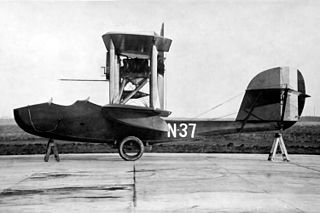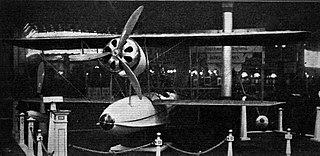Related Research Articles

The AD Flying Boat was designed by the British Admiralty's Air Department to serve as a patrol aircraft that could operate in conjunction with Royal Navy warships. Intended for use during the First World War, production of the aircraft was terminated as the end of the war came into sight, and the type saw little operational use. A number were repurchased after the end of the war by Supermarine Aviation and rebuilt as civil transports, becoming known as the Supermarine Channel.

Between 1911 and 1914, the Royal Aircraft Factory used the F.E.2 designation for three quite different aircraft that shared only a common "Farman" pusher biplane layout.

The Vickers F.B.5 was a British two-seat pusher military biplane of the First World War. Armed with a single .303 in (7.7 mm) Lewis gun operated by the observer in the front of the nacelle, it was the first aircraft purpose-built for air-to-air combat to see service, making it the world's first operational fighter aircraft.

The Airco DH.10 Amiens was a British twin-engined heavy bomber designed and built towards the end of the First World War. It served briefly postwar with the RAF.

The Supermarine Type 322 was a prototype British carrier-borne torpedo, dive bomber and reconnaissance aircraft of the Second World War. A single-engined monoplane, it was unsuccessful, with only two examples being built. The Fairey Barracuda, built to the same specification, would fill this role.
The Supermarine Baby was a British flying boat fighter aircraft of the First World War designed and built by the Supermarine Aviation Works. Although only one was built, it formed the basis for the later Sea King fighter and Sea Lion I racer.

The Vickers F.B.26 Vampire was a British single-seat pusher biplane fighter built by Vickers during the First World War.

The Short Type 320, also known as the Short Admiralty Type 320, was a British two-seat reconnaissance, bombing and torpedo-carrying "folder" seaplane of the First World War.

The Norman Thompson N.T.2B was a British single-engined flying boat trainer of the First World War. A single-engined biplane, the N.T.2B was adopted as a standard flying boat trainer by the Royal Naval Air Service, training pilots for larger patrol flying boats such as the Felixstowe F.2.
The Short N.2B was a prototype British patrol seaplane of the First World War, designed and built by Short Brothers. A single-engined biplane intended to replace Short's successful Type 184, only two were built, the Fairey III being preferred.
The Westland N.1B was a prototype British single-engined floatplane fighter aircraft of the First World War. The first aircraft to be designed by Westland Aircraft, it was a single-engined tractor biplane. Despite good performance, only two aircraft were built, the Royal Naval Air Service operating landplane fighters from ships instead.

The Norman Thompson N.1B was a prototype British flying boat fighter aircraft of the First World War. A two-seat single-engined pusher biplane, a single example was built in 1917, but no production followed.
The Armstrong Whitworth Sissit, also known as the Armstrong Whitworth F.K.1, was a prototype single-engined biplane fighter aircraft of the First World War. The first aircraft designed by Armstrong Whitworth, the Sissit was underpowered and only a single example was built.
The Vickers E.F.B.8 was a prototype British twin-engined fighter of the First World War. It was abandoned after only one aircraft was built, single-engined fighters being considered to have superior manoeuvrability.
The Sopwith Gunbus was a British fighter aircraft of the First World War. It was a single-engined pusher biplane based on a floatplane built by Sopwith before the war for Greece. Small numbers were built and used by the British Royal Naval Air Service, mainly as a trainer.
The Vickers F.B.24 was a British two-seat fighter aircraft of the First World War. Only a few prototypes were built, as, although it had good performance, the Bristol F.2 Fighter was preferred.
The Port Victoria P.V.4 was a prototype two-seat reconnaissance floatplane of the First World War. The P.V.4 was a small single engined pusher biplane. It was unsuccessful as the engine it was designed around was a failure and alternatives were unsuitable, only one aircraft being built.

The Sopwith 2B2 Rhino was a British two-seat triplane bomber designed and built by Sopwith Aviation Company as a private venture. The Rhino was powered by a 230 hp (172 kW) Beardmore Halford Pullinger inline piston engine. Only two aircraft were built and the type did not enter production.

The Pemberton-Billing P.B.1, sometimes known as the Supermarine, was a 1910s British single-seat flying-boat built by Pemberton-Billing Limited, which later became the Supermarine Aviation Works. Only one P.B.1 was built, and it never flew any distance further than a hop.
References
- Notes
- Bibliography
- Andrews, C. F., and Morgan, E. B. Supermarine Aircraft since 1914. London:Putnam, 1987, ISBN 0-85177-800-3.
- Bruce, J.M . British Aeroplanes 1914-18. London:Putnam, 1957.
- Mason, Francis K. The British Bomber since 1914. London:Putnam, 1994. ISBN 0-85177-861-5.